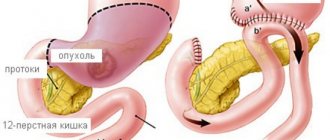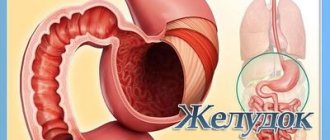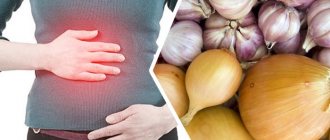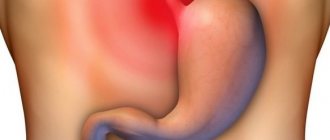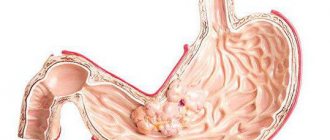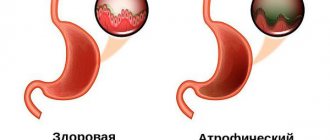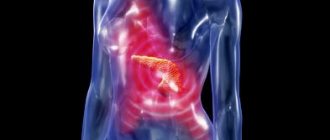Dyspepsia or indigestion is a disorder of the normal functioning of the stomach, painful and difficult digestion. Indigestion syndromes may include: pain and discomfort in the form of heaviness, fullness, early saturation in the epigastric (epigastric) region, near its midline.
According to statistical studies, every fourth inhabitant of the earth may experience symptoms of indigestion or dyspepsia. The reasons for the appearance of this pathology can be very diverse.
Main types of indigestion
Improper diet leads to indigestion.
The term indigestion refers to a whole range of different diseases.
But they are all united by the causes of the disease. The most common causes of diseases include:
- lack of proper diet;
- stress, especially long-term;
- nutritional imbalance;
- bad habits such as smoking, drinking alcohol;
- frequent consumption of sweet, spicy, fried and fatty foods;
- very frequent consumption of exotic foods not typical for our climate, to
- for which our digestive system is not sufficiently adapted - these are bananas, grapefruits, oranges and many others;
- ionizing radiation;
- rapid climate change during long trips;
- organic disorders in the gastric mucosa;
- infectious causes (for example, the bacterium Helicobacter pylori);
- negative infrasonic impact;
- taking medications.
Types of indigestion are divided into two groups: organic and functional. Organic types of indigestion include:
- stomach ulcer;
- gastroesophageal reflex disease;
- chronic pancreatitis;
- cholelithiasis;
- diseases of the endocrine system;
- pregnancy.
Sometimes, after a thorough examination, these diseases cannot be diagnosed; in this case, a diagnosis is made - functional dyspepsia (colloquially called indigestion). The diseases of functional dyspepsia include several variants:
- ulcer-like (the patient experiences pain in the epigastric region on an empty stomach or at night, the pain may go away after eating);
- dyskinetic (the patient complains of early satiety with food, accompanied by a feeling of fullness in the stomach, nausea, bloating in the epigastric region and a feeling of discomfort after eating);
- not specific (the patient’s complaints are difficult to identify).
Indigestion can occur even at an early age in children. It may be caused by a mismatch between the amount of food and its composition and the capabilities of the child’s digestive system. This could be simply overfeeding the baby or untimely introduction of new foods to the diet.
At an older age, indigestion in children occurs due to hormonal imbalance in the transition (puberty) period. Let us consider, in more detail, some manifestations of functional dyspepsia.
Functional dyspepsia in children
Indigestion or simple dyspepsia is more common in children in the first years of life. It can develop acutely or against the background of precursors: anxiety, loss of appetite, regurgitation, increased bowel movements. After 3-4 days, the frequency of stool reaches 5-7 times a day, it becomes liquid, heterogeneous in color, resembling the appearance of a chopped egg with lumps of white, yellow and greenish color, mixed with mucus. With dyspepsia, children experience bloating, frequent passing of gas, regurgitation, and vomiting. The child is bothered by intestinal colic: before defecation, he twists his legs and cries. Appetite decreases to the point of refusing to eat, which leads to a halt in weight gain. Simple dyspepsia in children lasts 2-7 days. Against the background of dyspepsia, children may develop thrush, stomatitis, and diaper rash.
Fermentative dyspepsia
Fermentative dyspepsia occurs due to the consumption of foods with large amounts of carbohydrates.
The reasons for its occurrence include the predominance of foods containing a lot of carbohydrates in food. These include products containing fructose, glucose, sucrose, starch and other types of carbohydrates.
Products containing them include white sugar, honey, fruits, berries, flour products, potatoes and many others.
The consumption of kvass, beer, and fermented foods can also lead to increased fermentation processes in the digestive system. Sugars entering the digestive system contribute to an increase in the number of bacteria responsible for fermentation processes in the digestive tract.
Soap or fat dyspepsia
Treatment of dyspepsia should be trusted to specialists.
This type of indigestion is caused by eating foods that contain solid fats, mainly of animal origin.
These are beef, lamb, pork fat and fats of other animals. Although this group of fats can also include fat of vegetable origin, such as palm oil.
There are other types of dyspepsia or indigestion, the cause of which may be a lack of production of various enzymes in the human body:
- cholecystogenic (develops with disorders associated with the secretion of bile into the duodenum);
- gastrogenic (associated with disturbances in the secretory function of the stomach walls and when part of the stomach is removed);
- pancreatogenic (for disorders associated with the enzymatic work of the pancreas);
- enterogenous (associated with enzymatic deficiency in the functioning of the intestinal walls, can also occur when part of the intestine is removed);
- mixed.
Indigestion associated with disturbances in the process of intestinal absorption
Indigestion is accompanied by pain in the abdomen.
This type of dyspepsia is very often caused by congenital malabsorption syndrome. This disease is characterized by disturbances in the absorption of nutrients and water through the intestinal walls.
The absorption of nutrients by the intestinal walls may be impaired by complications caused by infectious diseases. Let's look at some types of dyspepsia associated with intestinal infections.
Stomach neurosis: symptoms
The clinical signs of this disease are:
- discomfort in the stomach. The patient feels either fullness or emptiness in the abdomen. This may be accompanied by pain;
- aversion to food. Nausea occurs at the smell or sight of it. There may be vomiting. Very often the symptom is confused with a sign of anorexia or bulimia;
- hunger. This feeling persists even after a person has recently eaten;
- cardiopalmus. With neurosis, the patient often has pain in the heart and heaviness in the chest;
- unhealthy sleep. Another symptom of this disease. Many people have disrupted sleep patterns and are unable to fall asleep or wake up on time. Insomnia may develop, and as a result, severe headaches;
- heartburn. Unlike the usual one, not associated with neurosis, it does not go away after following a special diet;
- aerophagia or belching. Appears after swallowing a large amount of air. With neuroses, a person may make strange loud sounds while belching;
- aggressiveness. This symptom accompanies all problems with the nervous system. With gastric neurosis, the patient's irritability can also develop into panic attacks and various phobias. At the first symptoms, it is advisable to consult a doctor.
Diagnostics
When diagnosing various diseases associated with indigestion in the digestive system, all factors must be taken into account. The first thing the doctor does is analyze the history of complaints and illness. To be specified:
- when and how long ago pain and discomfort in the abdominal area began;
- frequency of their occurrence;
- the connection between these manifestations of the disease and food intake;
- duration of heartburn or discomfort;
- individual connection between the occurrence of these symptoms.
Life history analysis
The doctor finds out whether the patient has diseases associated with the gastrointestinal tract (gastritis (inflammation of the stomach), gastric ulcer, cholecystitis (inflammation of the gallbladder), duodenal ulcer and others.
Laboratory research
A blood test will help make a diagnosis.
A biochemical and clinical blood test is performed. It will help identify the causes of the inflammatory process and disturbances in the functioning of the digestive organs (stomach, liver, pancreas, intestines).
Reasons for development
Most often, dyspepsia is considered as a psychosocial disease that develops with frequent exposure to a stress factor on the human body. First of all, under the influence of stress, the functional state of the stomach is disrupted, after which all structures of the gastrointestinal tract are involved in the process. In addition to the psycho-emotional factor, factors such as poor nutrition, a poor, monotonous diet, taking certain groups of medications (antibiotics, non-steroidal anti-inflammatory drugs), hypersecretion of gastric juice, enzymatic deficiency, as well as infection with the bacterium Helicobacter Pylori can lead to functional dyspepsia.
Other causes of dyspepsia include:
- cholelithiasis;
- gastritis and gastric ulcer;
- achlorhydria;
- pancreatitis;
- pyloric stenosis;
- benign and malignant neoplasms of the gastrointestinal tract;
- infectious lesion of the gastrointestinal tract;
- diaphragmatic hernia;
- cholecystitis, as well as previous surgery to remove the gallbladder.
Treatment
If symptoms of dyspepsia or indigestion appear, we recommend drug and non-drug treatment.
Non-medicinal recommendations
Colonoscopy is a method for examining indigestion.
For symptoms associated with disorders of the gastrointestinal tract, it is recommended:
- use a small pillow when sleeping;
- after eating, walk in the fresh air for 30 to 60 minutes;
- do not wear clothes that are too tight;
- When carrying out physical exercises, avoid bending, twisting and lifting the body;
- monitor the rationality and balance of your diet;
- limit consumption or completely eliminate the following foods: citrus fruits, carbonated drinks, alcoholic beverages, white sugar and other carbohydrate-containing foods, salted, spicy, smoked, fried, fatty, meat products;
- make sure that among your food products there are no stale or low-quality products;
- don't overeat.
How to eat during an acute period
The first, in the form of light soups, should be present every day.
In the first 1-2 days after the onset of an exacerbation, it is not recommended to eat at all. Allowed to take 1.5-2 liters of liquid. This can be tea with or without lemon, rosehip infusion, and almost no sugar is used.
By the middle of the second day, you can switch to a gentle diet, consisting of slimy soups, pureed porridges, jelly with white bread croutons.
Soufflés made from pureed lean meat, fish, milk creams, soft-boiled eggs, and milk are acceptable. Sauces and spices, fermented milk products, fresh bread, fresh fruits, confectionery, cocoa, coffee, and carbonated drinks are completely excluded. Salt is used to a minimum when preparing dishes.
This diet eliminates irritation of the walls of the stomach and its mucous membrane, and does not cause increased production of gastric juice. Gastroenterologists do not recommend staying on this diet for long and, at the first opportunity, switching to an expanded diet with a large number of permitted foods.
